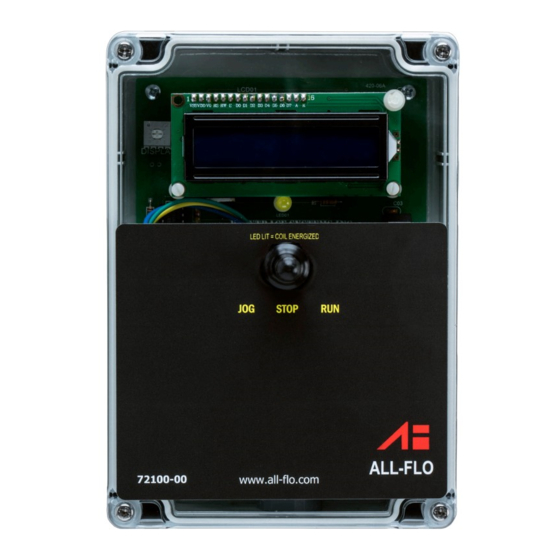Dover All-Flo PSG 72100-00 Instalação, operação e manutenção - Página 4
Procurar online ou descarregar pdf Instalação, operação e manutenção para Controlador Dover All-Flo PSG 72100-00. Dover All-Flo PSG 72100-00 8 páginas. Batch controller

2
SECTION
PRINCIPLES OF OPERATION
72100-00 BATCH CONTROLLER
The 72100-00 controller works by adjusting the time interval between
the signals sent to the solenoid controlled AODD pump. These signals
dictate when the pump will discharge one of the fluid chambers of
the pump. This discharge of a single fluid chamber is referred to as a
"stroke". The 72100-00 controller is engineered to provide speed control
of a solenoid-controlled pump that is linearly proportional to a 4-20 ma
signal. The signal can be set to have a speed range of 1 to 499 Strokes/
Minute.
You must use the appropriate pump solenoid when using a 72100-00
controller. The system requires 110 volts AC to power it and delivers 12
volts DC to the pump solenoid. The system can be operated using the
toggle switch on the cover of the unit or by connecting a "SPDT center-
off" switch (or a set of dry-contacts) remotely. The connections for
remote usage are a terminal strip, also on the circuit board. The system
uses Strokes/Minute units which are very useful in estimating fluid
delivery rates and permit linear calculations.
ALL-FLO'S SOLENOID CONTROLLED PUMPS
All-Flo's solenoid pumps use the compressed air to displace fluid in the
same way as a standard Air Operated Double Diaphragm (AODD) pump
while using electric pulses to control the pump speed. The use of a
solenoid pump allows the user to have more control over the operation.
The solenoid pump uses an electrical pulse to energize the solenoid
valve attached to the air end of the pump. These electronic pulses are
sent in the form of a square wave (Figure 1).
The energized pulses move the solenoid valve connecting the different
ports changing how the air flows. In Figures 2 and 3, port 1 denotes the
connection to the air supply, ports 2 and 4 denote the ports leading the
air chambers, and ports 3 and 5 denote the ports that are open to the
atmosphere.
While the solenoid is de-energized, the valve sits at its standard position,
allowing pressurized air from the air supply (port 1) into one of the
air chambers of the pump (port 2). The other air chamber (port 4) is
connected the exhaust (port 5), discharging any pressurized air in that
chamber.
When the pulse is received, the solenoid energizes and moves the valve
to its energized position (Figure 3).
While the solenoid is energized, the pressurized air from the air supply
(port 1) flows into the air chamber of the pump (port 4). The other air
chamber (port 2) is connected the exhaust (port 3), discharging any
pressurized air in that chamber.
This pulsating energized and de-energized states mimics the air flow
cycle cause by the pilot sleeve in the standard pump. The faster these
pulses are applied, the quicker the pump operates.
ALF-14021-E-01
4
Energized
De-energized
FIGURE 1
SQUARE WAVE
FIGURE 2
DE-ENERGIZED
SOLENOID POSITION
FIGURE 3
ENERGIZED
SOLENOID POSITION
All-Flo
